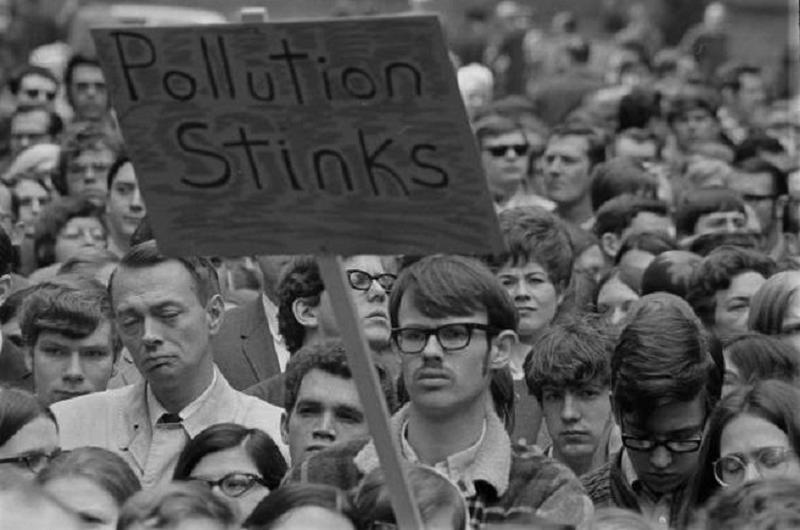The First Earth Day
By | April 16, 2022

On April 10, 1872, the first Arbor Day was celebrated in Nebraska, as they set out to plant trees. On that first Arbor Day, it is estimated that more than 1 million trees were planted in Nebraska. Arbor Day became national after that, however, in the 1960s, Americans still had limited laws to protect the air and water, and the Environmental Protection Agency was not established until December 2, 1970. Water and air pollution were essentially the norm as cars were still using leaded gas and industries faced few repercussions for pollution. The country was focused on the war in Vietnam as well as other domestic strife and dedicated little time to environmental problems.
In 1962, Rachel Carson published Silent Spring, an international bestseller that began to raise awareness about environmental concerns and showed the link between the environment and public health. That same year, Gaylord Nelson was elected to the US Senate, where he remained until 1980. Nelson, who had served two terms as the Governor of Wisconsin, was dubbed “the Conservation Governor” because of his efforts. He believed that economic prosperity was not at odds with environmental protection. In 1963, Nelson convinced President John F. Kennedy to embark on a national speaking tour to talk about environmental issues.

The Roots Of Earth Day
Senator Nelson noted the success of the anti-war teach-ins which were being used for mobilizing students to protest the Vietnam War and thought that it might be a good tool to raise awareness about environmental concerns, so he envisioned a “national teach-in on the environment” as a way to bring the issues into the national spotlight.
In January 1969, there was a massive oil spill in Santa Barbara California which came to national attention, and later that year, in September, Nelson began his advocacy for Earth Day. He called for Americans to come together in the following spring for a day focused on environmental education. People responded with tremendous enthusiasm, which led Nelson to establish an organization to help people prepare as it was slated to be a nationwide event. Nelson convinced a Republican Congressman, Pete McCloskey, to serve as his co-chair (Nelson was a Democrat) and he hired Dennis Hayes, a former intern, to work as the national coordinator. Nelson also put together a staff of 85 people to promote events nationwide. Additionally, Nelson created a steering committee. This committee was comprised of students, academics, environmentalists, and scientists.

The Purpose Of The National Office
The aim of the national office was to support grassroots efforts across the country since different areas were facing their own unique ecological problems; each community would be celebrating Earth Day in its own way. They chose April 22 to be the official Earth Day (according to some rumors, they chose this date as it was between spring break and final exams).

Events Focused On Local Issues
During the first Earth Day, Americans marched and demonstrated. An estimated 20 million Americans participated on that day, including people from 10,000 elementary and high schools, 2,000 colleges, and over 1,000 communities. The day was a success in the number of participants, but also in their diversity. It brought together Republicans and Democrats, union members, farmers, scientists, and politicians in support of the environment. At the time, this was 10% of the total population in America. Local autonomy was important, and events were organized around the needs of their particular communities. For example, in East Coast cities, the focus was often on urban problems such as abandoned cars and poor highway planning. They made a concerted effort to include poor and minority communities as well so that the issues they faced were being addressed.

Nelson, Hayes, And Other Members Spoke Around The Country
Although Environmental Teach-In, Inc. simply functioned as a coordinating organization, members of the staff spoke at local events and supported groups across the country. Nelson himself gave a speech in Denver. Dennis Hayes, meanwhile, remained in Washington D.C., giving a speech at the Sylvan Theater, proclaiming that Earth Day “is a movement with a broad base, a movement which transcends traditional political boundaries. It is a movement that values people more than technology, people more than political boundaries, and political ideologies, people more than profit. It will be a difficult fight. Earth Day is the beginning.”

Earth Day Made A Tremendous Impact
Shortly after the first Earth Day, the EPA was created, and important legislation was passed, including the Clean Air Act, the Resource Conservation and Recovery Act, the Endangered Species Act, the Safe Drinking Water Act, and the Occupational Safety and Health Act. In 1990, Earth Day became a global event, reaching over 200 million people in 141 countries, and creating a foundation for the 1992 United Nations Earth Summit in Rio de Janeiro. Earth Day 2000 focused on climate change and clean energy and saw an increase in global participation. In 1995, then-President Bill Clinton awarded Nelson with the Presidential Medal of Freedom. Gaylord Nelson died on July 3, 2005.
